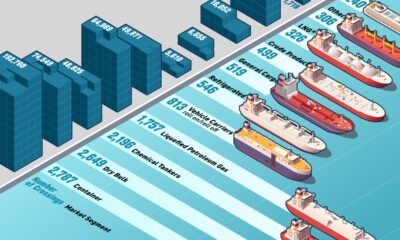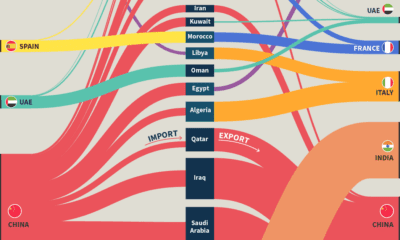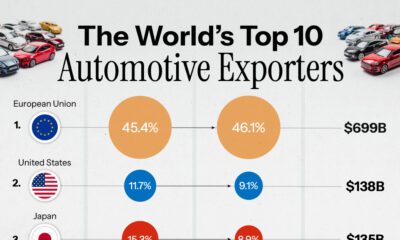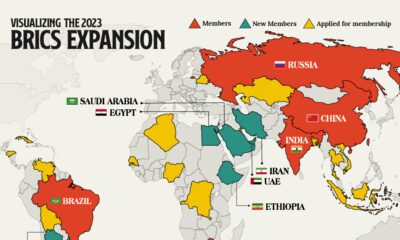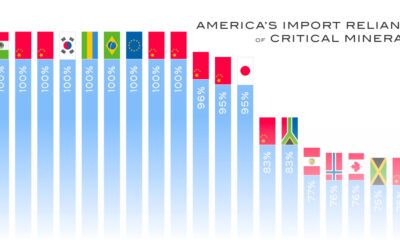Markets
Visualizing 150 Years of Exports for Top Economic Superpowers
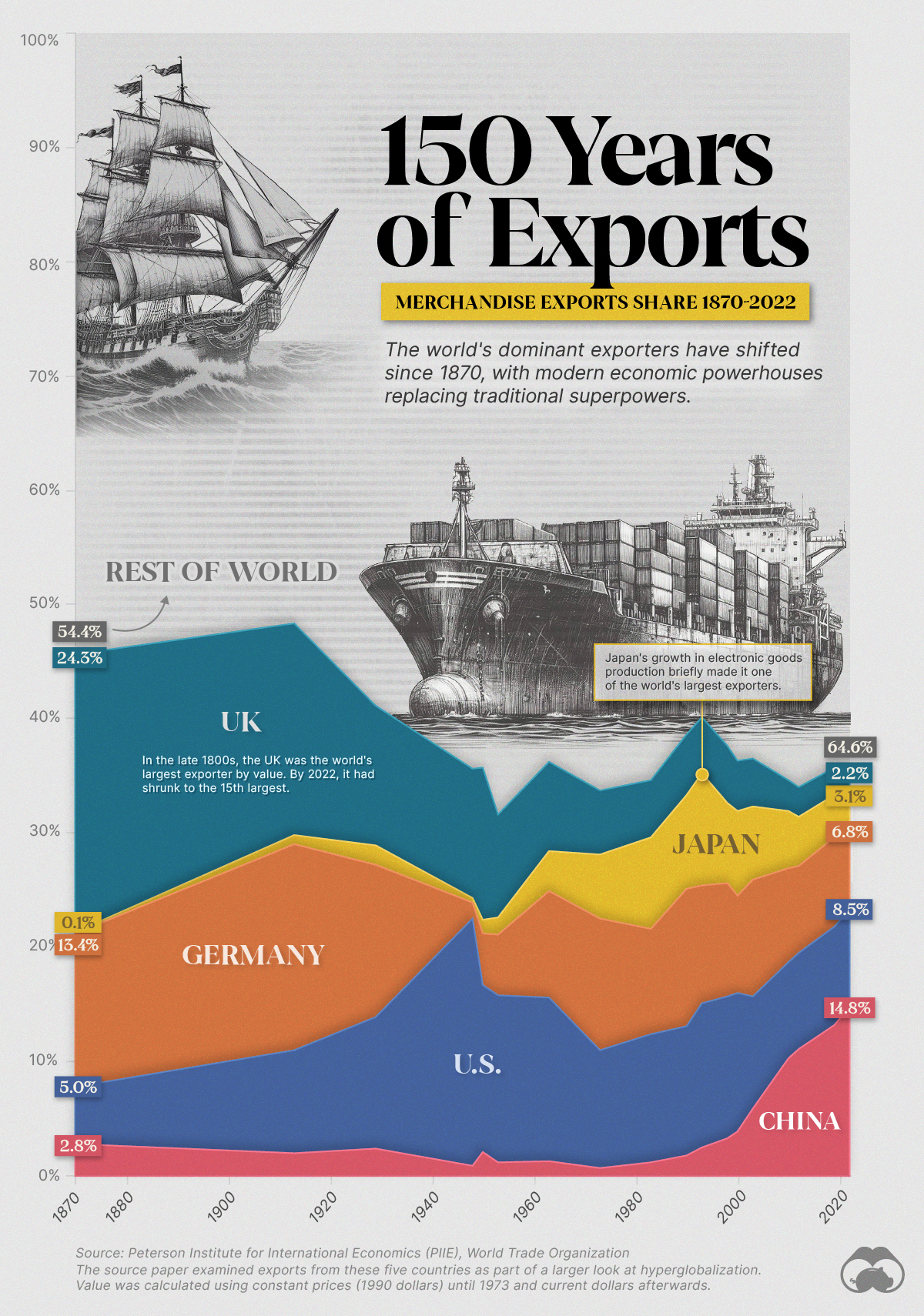
150 Years of Exports by Economic Superpowers
Historically, the biggest economies in the world have also been those that dominate international trade overseas.
This visualization uses data from the Peterson Institute for International Economics (PIIE) and the World Trade Organization to show how global export shares by value have changed over the last 150 years for some of the world’s top powers.
Merchandise Exports Share 1870-2022
During the 19th century, Britain was the world’s richest and most advanced economy. The economy was the most industrialized globally, with one-third of the population employed in manufacturing.
As a result, the UK’s finished goods were produced so efficiently and cheaply that they were widely traded worldwide, and were easily found in almost any other market.
Additionally, the British Empire benefited from its colonies, with India representing 42% of its exports by the end of the century.
During that period, Britain dominated merchandise exports, followed by Germany:
| Year | UK | Germany | U.S. | Japan | China | ROW |
|---|---|---|---|---|---|---|
| 1870 | 24.3% | 13.4% | 5.0% | 0.1% | 2.8% | 54.4% |
| 1913 | 18.5% | 18.0% | 9.0% | 0.8% | 2.0% | 51.7% |
| 1929 | 12.2% | 13.3% | 11.5% | 1.7% | 2.4% | 58.9% |
| 1948 | 11.3% | 1.4% | 21.6% | 0.4% | 0.9% | 64.4% |
| 1950 | 13.3% | 4.5% | 14.6% | 1.2% | 2.1% | 64.3% |
| 1953 | 9.0% | 5.3% | 14.6% | 1.5% | 1.2% | 68.4% |
| 1963 | 7.8% | 9.3% | 14.3% | 3.5% | 1.3% | 63.8% |
| 1973 | 5.6% | 11.5% | 10.3% | 5.6% | 0.7% | 66.3% |
| 1983 | 5.0% | 9.2% | 11.2% | 8.0% | 1.2% | 65.4% |
| 1990 | 5.3% | 12.0% | 11.3% | 8.2% | 1.8% | 61.4% |
| 1993 | 4.9% | 10.3% | 12.6% | 9.8% | 2.5% | 59.9% |
| 1998 | 5.0% | 9.9% | 12.4% | 7.0% | 3.3% | 62.4% |
| 2000 | 4.4% | 8.5% | 12.1% | 7.4% | 3.9% | 63.7% |
| 2003 | 4.2% | 10.2% | 9.8% | 6.4% | 5.9% | 63.5% |
| 2010 | 2.7% | 8.2% | 8.4% | 5.0% | 10.3% | 65.4% |
| 2012 | 2.6% | 7.6% | 8.4% | 4.3% | 11.1% | 66.0% |
| 2019 | 2.4% | 7.8% | 8.6% | 3.7% | 13.2% | 64.3% |
| 2022 | 2.2% | 6.8% | 8.5% | 3.1% | 14.8% | 64.6% |
After World War II, the U.S. overtook British and German export leadership.
Unlike Europe and many other parts of the world that experienced devastation and economic hardship due to the war, the U.S. emerged relatively unscathed in terms of physical destruction and with a significantly strengthened industrial base.
Asian Growth from the 1980s to the Present
During the 1980s and 1990s, Japan experienced rapid export growth, driven by electronics-related goods, and became one of the largest trading partners of the United States.
Today, China dominates the trade market, accounting for almost 15% of all merchandise.
China’s manufacturing industry has become a leader in producing almost anything from commonplace household items to integral pieces in automotive manufacturing. Some staples of Chinese manufacturing are:
- Precision instruments
- Semiconductors
- Industrial machinery for computers and smartphones
Since 1948, global merchandise exports have grown from $59 billion to $24.3 trillion in 2022.
Markets
The European Stock Market: Attractive Valuations Offer Opportunities
On average, the European stock market has valuations that are nearly 50% lower than U.S. valuations. But how can you access the market?

European Stock Market: Attractive Valuations Offer Opportunities
Europe is known for some established brands, from L’Oréal to Louis Vuitton. However, the European stock market offers additional opportunities that may be lesser known.
The above infographic, sponsored by STOXX, outlines why investors may want to consider European stocks.
Attractive Valuations
Compared to most North American and Asian markets, European stocks offer lower or comparable valuations.
| Index | Price-to-Earnings Ratio | Price-to-Book Ratio |
|---|---|---|
| EURO STOXX 50 | 14.9 | 2.2 |
| STOXX Europe 600 | 14.4 | 2 |
| U.S. | 25.9 | 4.7 |
| Canada | 16.1 | 1.8 |
| Japan | 15.4 | 1.6 |
| Asia Pacific ex. China | 17.1 | 1.8 |
Data as of February 29, 2024. See graphic for full index names. Ratios based on trailing 12 month financials. The price to earnings ratio excludes companies with negative earnings.
On average, European valuations are nearly 50% lower than U.S. valuations, potentially offering an affordable entry point for investors.
Research also shows that lower price ratios have historically led to higher long-term returns.
Market Movements Not Closely Connected
Over the last decade, the European stock market had low-to-moderate correlation with North American and Asian equities.
The below chart shows correlations from February 2014 to February 2024. A value closer to zero indicates low correlation, while a value of one would indicate that two regions are moving in perfect unison.
| EURO STOXX 50 | STOXX EUROPE 600 | U.S. | Canada | Japan | Asia Pacific ex. China |
|
|---|---|---|---|---|---|---|
| EURO STOXX 50 | 1.00 | 0.97 | 0.55 | 0.67 | 0.24 | 0.43 |
| STOXX EUROPE 600 | 1.00 | 0.56 | 0.71 | 0.28 | 0.48 | |
| U.S. | 1.00 | 0.73 | 0.12 | 0.25 | ||
| Canada | 1.00 | 0.22 | 0.40 | |||
| Japan | 1.00 | 0.88 | ||||
| Asia Pacific ex. China | 1.00 |
Data is based on daily USD returns.
European equities had relatively independent market movements from North American and Asian markets. One contributing factor could be the differing sector weights in each market. For instance, technology makes up a quarter of the U.S. market, but health care and industrials dominate the broader European market.
Ultimately, European equities can enhance portfolio diversification and have the potential to mitigate risk for investors.
Tracking the Market
For investors interested in European equities, STOXX offers a variety of flagship indices:
| Index | Description | Market Cap |
|---|---|---|
| STOXX Europe 600 | Pan-regional, broad market | €10.5T |
| STOXX Developed Europe | Pan-regional, broad-market | €9.9T |
| STOXX Europe 600 ESG-X | Pan-regional, broad market, sustainability focus | €9.7T |
| STOXX Europe 50 | Pan-regional, blue-chip | €5.1T |
| EURO STOXX 50 | Eurozone, blue-chip | €3.5T |
Data is as of February 29, 2024. Market cap is free float, which represents the shares that are readily available for public trading on stock exchanges.
The EURO STOXX 50 tracks the Eurozone’s biggest and most traded companies. It also underlies one of the world’s largest ranges of ETFs and mutual funds. As of November 2023, there were €27.3 billion in ETFs and €23.5B in mutual fund assets under management tracking the index.
“For the past 25 years, the EURO STOXX 50 has served as an accurate, reliable and tradable representation of the Eurozone equity market.”
— Axel Lomholt, General Manager at STOXX
Partnering with STOXX to Track the European Stock Market
Are you interested in European equities? STOXX can be a valuable partner:
- Comprehensive, liquid and investable ecosystem
- European heritage, global reach
- Highly sophisticated customization capabilities
- Open architecture approach to using data
- Close partnerships with clients
- Part of ISS STOXX and Deutsche Börse Group
With a full suite of indices, STOXX can help you benchmark against the European stock market.

Learn how STOXX’s European indices offer liquid and effective market access.

-

 Economy2 days ago
Economy2 days agoEconomic Growth Forecasts for G7 and BRICS Countries in 2024
The IMF has released its economic growth forecasts for 2024. How do the G7 and BRICS countries compare?
-

 Markets1 week ago
Markets1 week agoU.S. Debt Interest Payments Reach $1 Trillion
U.S. debt interest payments have surged past the $1 trillion dollar mark, amid high interest rates and an ever-expanding debt burden.
-

 United States2 weeks ago
United States2 weeks agoRanked: The Largest U.S. Corporations by Number of Employees
We visualized the top U.S. companies by employees, revealing the massive scale of retailers like Walmart, Target, and Home Depot.
-

 Markets2 weeks ago
Markets2 weeks agoThe Top 10 States by Real GDP Growth in 2023
This graphic shows the states with the highest real GDP growth rate in 2023, largely propelled by the oil and gas boom.
-

 Markets2 weeks ago
Markets2 weeks agoRanked: The World’s Top Flight Routes, by Revenue
In this graphic, we show the highest earning flight routes globally as air travel continued to rebound in 2023.
-

 Markets3 weeks ago
Markets3 weeks agoRanked: The Most Valuable Housing Markets in America
The U.S. residential real estate market is worth a staggering $47.5 trillion. Here are the most valuable housing markets in the country.
-

 Education1 week ago
Education1 week agoHow Hard Is It to Get Into an Ivy League School?
-

 Technology2 weeks ago
Technology2 weeks agoRanked: Semiconductor Companies by Industry Revenue Share
-

 Markets2 weeks ago
Markets2 weeks agoRanked: The World’s Top Flight Routes, by Revenue
-

 Demographics2 weeks ago
Demographics2 weeks agoPopulation Projections: The World’s 6 Largest Countries in 2075
-

 Markets2 weeks ago
Markets2 weeks agoThe Top 10 States by Real GDP Growth in 2023
-

 Demographics2 weeks ago
Demographics2 weeks agoThe Smallest Gender Wage Gaps in OECD Countries
-

 Economy2 weeks ago
Economy2 weeks agoWhere U.S. Inflation Hit the Hardest in March 2024
-

 Green2 weeks ago
Green2 weeks agoTop Countries By Forest Growth Since 2001




